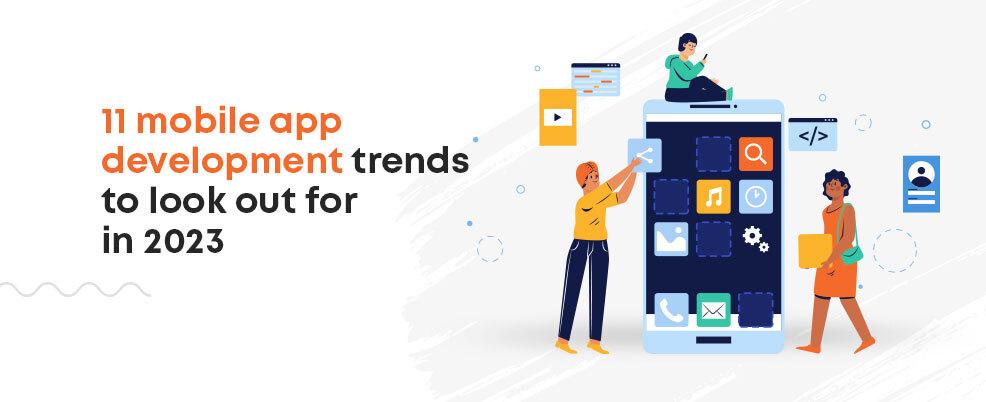The mobile app development industry is constantly evolving. Most businesses are trying to attract potential clients via mobile applications as it is the sole gadget that is always on our side – at work, at home, or even on vacation – as smartphones have become an extension of our lives.
What is ahead for mobile application development in the future year, as the mobile app industry continues to grow significantly in 2023? What trends and possibilities should mobile software developers and engineers be aware of in order to stay competitive?
In this article, we will highlight the recent and emerging trends to watch for this year.
11 Mobile App Development Trends for 2023
Knowing the newest mobile app development trends might help you adapt when user expectations and market conditions shift rapidly.
1. 5G
5G networks will meet consumer demand for a strong mobile network with faster performance, faster data transfer, and reduced latency. 5G may be used by mobile app developers to increase app functionality and incorporate new features such as immersive augmented reality (AR) and virtual reality (VR) experiences, improved live-streaming, and enhanced cloud capabilities.
2. IoT and cloud
As companies attempt to build seamless links between smart devices and mobile applications, the need for mobile app development services is increasing in manufacturing, healthcare, and retail.
There are several benefits to using the cloud and the Internet of Things (IoT), including increased productivity, cheaper operational costs, and more API connections to other platforms. Manufacturers, for example, use IoT mobile applications to monitor remote work sites or the performance of their equipment.
3. AI and machine learning
As user expectations for personalized app experiences rise, artificial intelligence (AI) and machine learning (ML) will continue to be essential components of mobile app development Real-time data collection and user behavior analytics will allow apps to personalize search, chatbot interactions, and app authentication for seamless user experiences. ML may leverage analytics to personalize news feeds, provide AI-powered chatbots that are aware of a customer’s past and communication preferences, and identify fraud, dubious activity, and potential data breaches.
4. Mobile commerce
Mobile commerce, often known as m-commerce, is making online purchases using a mobile app rather than a mobile website. As more people use applications, m-commerce is quickly growing. Mobile wallets and in-app payment methods also make it easier for customers to make purchases without leaving the app. Numerous retailers are developing native applications or progressive web apps to enhance the shopping experience (PWAs).
5. Wearables
Particularly in the sports and healthcare sectors, wearable technology is still extensively embraced. Users may get messages and notifications conveniently while on the road thanks to wearables like fitness trackers. Given the improvements made to newer models and the accessibility of 5G connections, the demand for mobile apps for wearable technology is expanding, which is not surprising. Mobile app developers will need to focus on making entertaining, responsive, and user-friendly apps if they want to keep up with this trend.
6. Beacon technology
Beacons were introduced in 2013, but they are growing increasingly popular in mobile app development, notably for retail enterprises, where beacon deployments increased revenue share to more than 65% in 2021. Beacon technology is transforming business because it uses Bluetooth low-energy signals to communicate data based on a user’s location. The benefits to consumers include localized, quick savings and alerts. By identifying customer buying preferences and behaviors through the use of beacons, businesses are able to provide more individualized shopping experiences.
7. AR/VR
As AR/VR technology progresses, mobile apps for gaming, entertainment, travel, and live broadcasting are changing. Customers want rich, immersive experiences, and thanks to AR/VR technology, they can try on clothes, picture themselves on the ideal beach getaway, or even see how a new couch might look in their living room. Mobile app developers are concerned with creating experiences that can be accessed and enjoyed on older mobile devices.
8. PWAs and instant apps
Progressive web applications (PWAs) are popular because they bridge the gaps that most native programs and web pages leave behind. PWAs are a popular choice for both users and businesses because of their advantages including decreased reliance on internet connections, quicker loading times, automated upgrades, and shorter time-to-market. Trivago, Forbes, and Pinterest are three popular PWA websites.
In a similar manner, people are becoming more and more attracted to instant apps since they enable testing before downloading and installing. Better performance, a better customer experience, and lower development costs are all benefits for businesses adopting PWAs and instant apps.
9. Cross-platform development
A mobile app that can be used on any iOS or Android platform is created utilizing cross-platform development, which uses a single codebase. By just having to develop the app once, you can save time and money and reach more consumers with a single app that works and looks the same across all platforms. Walmart, Instagram, and BMW are among the businesses that have cross-platform applications.
10. Low-code development
The development of a mobile app with low-code app development involves little to no coding experience. To design the app, developers instead utilize frameworks with user-friendly features like drag-and-drop, editors, and easy APIs. Low code may speed up and reduce costs associated with the development of apps, and it can be used by non-programmers. This makes it possible for your mobile app development team to innovate, operate more effectively, and get innovations to market faster. Mendix would be a great option because of its high-productivity app platform, which enables you to create and continuously improve mobile and web apps at scale with its No-code and Low-code options.
11. Voice recognition
One of the fastest-growing mobile app technologies is voice recognition, which satisfies user demand for shorter response times. Instead of typing a search query, customers use voice commands that the device can interpret to execute a function. Through the Amazon Alexa smartphone app, users may utilize the AI-powered Alexa virtual assistant to do things like check the weather or buy groceries.
Development Trends: Why Are They Important?
Every year, new versions of the technology are released into the market as it is evolving rapidly. There is a tonne of brand-new chances for app developers thanks to these market trends in mobile technology.
Future mobile app development will be guided by customer expectations. Customers want to be able to interact, do business, work, and enjoy entertainment right in their hands. Because of this, they will only accept a high-performing experience on their preferred device.
To stay on top of the mobile app development industry, keeping up with trends is essential. The Internet of Things, wearables, and cloud computing will all continue to gain popularity in 2023. Tecnolynx can help you realize your vision and guarantee the best performance for your mobile app as your partner in the industry.


